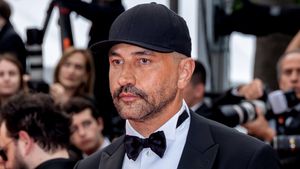
Treatment GuideJust DiagnosedSex & DatingAfrican AmericanStigmaAsk the HIV DocPrEP En EspañolNewsVoicesPrint IssueVideoOut 100
CONTACTCAREER OPPORTUNITIESADVERTISE WITH USPRIVACY POLICYPRIVACY PREFERENCESTERMS OF USELEGAL NOTICE
© 2025 Pride Publishing Inc.
All Rights reserved
All Rights reserved
Scroll To Top
By continuing to use our site, you agree to our Private Policy and Terms of Use.
Forty years ago Martin Luther King Jr. stood at the foot of the Lincoln Memorial addressing the nation and the world with a dream and a challenge. King's dream of equality, justice, and peace is embedded in our minds and hearts. His challenge to America to pay her promissory note to all her citizens is one we should not forget. While we have made much progress toward the fulfillment of King's dream, we are not there yet. African-Americans continue to be underrepresented in corporations, colleges, and elected offices'but overrepresented among the incarcerated, unemployed, and sufferers of chronic illnesses. Discrimination continues to plague our society. Today, King's dream is threatened by time, a new world order, new political priorities, and a new adversary more cunning and deadly than any of the anti'civil rights forces of the late '50s and early '60s: HIV. AIDS is devastating black, brown, and poor communities and destroying our families. This year we need to call on all people of goodwill to join in efforts to stop HIV from killing the dream.There are lessons we can learn from the 1963 march. Paralysis, stigma, denial, and lack of organization have often hampered our efforts to beat back AIDS. We all know about King's speech. But the march did not begin on the morning of August 28, 1963. And King was not the only leader. The chief architect of the 1963 march was a young Bayard Rustin, a pacifist, socialist, and homosexual. Other leaders in the march were Roy Wilkins, James Farmer, Whitney Young Jr., and the youngest speaker at the march, John Lewis. Every civil rights organization was called into service, along with each group's allies. Rustin was a master organizer. Months before the march he sent out manuals to thousands of organizations. The organizers identified stakeholders from all sectors. In the end, the march succeeded because failure was not an option and the organizers and their followers prepared for success. There is similar hope today still. This summer more than 300,000 African-Americans from all sectors of the black community attended black conferences and conventions. From professional organizations and fraternities and sororities to civil rights organizations and faith-based groups, traditional black institutions gathered in the months of June through August to review past accomplishments, analyze the state of black America, and set future agendas. Virtually every black leader and anyone with aspirations of becoming a black leader attended one or more of these gatherings. There is no better opportunity to get black communities across America to focus on a specific issue. This year one of the issues they focused on was HIV'at workshops, plenary sessions, and photo exhibits, and with special AIDS newsletters. People were told about the magnitude of the epidemic in their communities, urged to action, and given suggestions of what they might do in their local communities. There was a town hall meeting in Dallas attended by more than 2,500 people where over 400 of them got tested for HIV. In Los Angeles 45,000 newsletters were distributed. There is something going on. Maybe it's because it's the 40th anniversary of the 1963 march. Maybe folks are just sick and tired of being sick and tired. Whatever it is, we must share with them our dream of a world without HIV. Wilson is the founding director of the Los Angeles'based Black AIDS Institute.
From our Sponsors
Most Popular
Lexi Love comes out as HIV+ after Trump deletes federal resources
January 23 2025 11:23 AM
Ricky Martin delivers showstopping performance for 2024 World AIDS Day
December 05 2024 12:08 PM
Trump's orders prompt CDC to erase HIV resources
January 31 2025 5:29 PM
California confirms first case of even more deadly mpox strain
November 18 2024 3:02 PM
This long-term HIV survivor says testosterone therapy helped save his life.
December 16 2024 8:00 PM
Plus: Featured Video
Latest Stories
HRC holds 'die-in' to protest Trump health care cuts
April 28 2025 2:11 PM
The Talk Season 5 premieres this spring with HIV guidance for the newly diagnosed
March 26 2025 1:00 PM
Jess King is here to help you live your happiest, healthiest life yet
March 24 2025 4:35 PM
Gerald Garth is keeping people of color happy and healthy through trying times
March 11 2025 3:38 PM
'RuPaul's Drag Race' star Trinity K Bonet quietly comes out trans
December 15 2024 6:27 PM
Hollywood must do better on HIV representation
December 01 2024 9:00 AM
Post-election blues? Some advice from mental health experts
November 08 2024 12:36 PM
Two right-wing Supreme Court justices signal they may uphold access to PrEP and more
April 21 2025 4:10 PM
500,000 Children at Risk: PEPFAR Funding Crisis
April 08 2025 3:51 PM
Discover the power of Wellness in your life
March 26 2025 12:41 PM
BREAKING NEWS: Trump admin moves to end federal HIV prevention programs
March 18 2025 6:10 PM
Celebrating Black History Month with our annual African American issue
February 01 2025 3:28 PM
Plus nominated for 2025 GLAAD Media Award
January 22 2025 12:42 PM
AIDS Memorial Quilt displayed at White House for the first time
December 02 2024 1:21 PM
Broadway's best raise over $1 million for LGBTQ+ and HIV causes
April 03 2025 7:15 PM
Season 4 of The Switch on resilience & radical self-love returns this spring
March 26 2025 12:20 PM
Tyler TerMeer vows to continue to fight for health care for all
January 28 2025 3:00 PM
A camp for HIV-positive kids is for sale. Here's why its founder is celebrating
January 02 2025 12:21 PM
Decades of progress, uniting to fight HIV/AIDS
December 01 2024 12:30 PM
Climate change is disrupting access to HIV treatment
November 25 2024 11:05 AM










































































